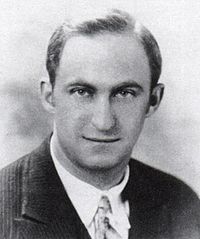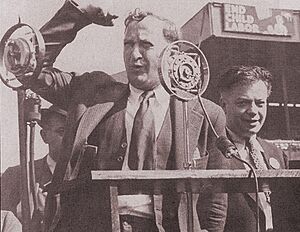Jay Lovestone facts for kids
Quick facts for kids
Jay Lovestone
|
|
|---|---|

Jay Lovestone circa 1917
|
|
| Born |
Jacob Liebstein
December 15, 1897 Molchad, Grodno gubernia, Lithuania (then Russian Empire)
|
| Died | March 7, 1990 (aged 92) Manhattan, New York City, United States
|
| Alma mater | City College of New York |
| Occupation | political activist |
| Years active | 1919-1982 |
| Political party | Socialist Party of America, Communist Party USA, AFL-CIO |
| Opponent(s) | Joseph Stalin, William Z. Foster, James P. Cannon |
| Partner(s) | Louise Page Morris |
Jay Lovestone (December 15, 1897 – March 7, 1990) was an American activist. He was involved in many different political groups during his life. He was a member of the Socialist Party of America and a leader of the Communist Party USA. Later, he became a strong opponent of communism. He even helped the Central Intelligence Agency (CIA) and advised leaders of the AFL-CIO, a large group of labor unions.
Contents
Jay Lovestone's Life Story
Early Life and Education
Jay Lovestone was born Jacob Liebstein in a small Jewish village called Moǔchadz. This village was in what is now Belarus, but at the time it was part of the Russian Empire. His father, Barnet, was a religious leader. When his family moved to America, his father worked as a caretaker.
The family arrived at Ellis Island in New York on September 15, 1907. They settled in Manhattan before moving to the Bronx. The family wasn't sure of their exact birth dates, so they chose December 15, 1897, for Jacob.
Young Jacob became interested in socialist ideas when he was a teenager. He read many newspapers about politics in New York. In 1915, he started attending City College of New York. He joined the college's student group for socialists. He became the secretary and then the president of this group. Here, he met friends like William Weinstone and Bertram Wolfe, who would later work with him in the Communist Party.
He graduated in June 1918. In February 1919, he legally changed his name to Jay Lovestone. This new last name was a direct translation of his original last name, Liebstein. Many Jewish immigrants changed their names during this time because of widespread unfair treatment in America. He also started studying law but soon left to work full-time for the Communist Party.
Years as a Communist Leader (1919–1929)
Lovestone became involved in the American Communist movement in 1919. He helped create the Communist Party of America in Chicago on September 1, 1919.
In 1921, Lovestone became the editor of The Communist, the party's newspaper. He also worked on The Liberator, a magazine about arts and literature. After Charles Ruthenberg died in 1927, Lovestone became the party's national secretary.
The Communist Party had two main groups, or "factions," in the 1920s. One group, led by John Pepper and Charles Ruthenberg (and later Lovestone), focused on working with other political groups. The other group, led by William Z. Foster and James P. Cannon, wanted to build a strong labor union movement.
Lovestone became a key leader in the Ruthenberg group. These groups in the US Communist Party were connected to different leaders in the Soviet Union. Lovestone's group supported Nikolai Bukharin, while Foster's group supported Joseph Stalin.
In 1928, James P. Cannon's group started supporting Leon Trotsky, another Soviet leader who disagreed with Stalin. Lovestone led the effort to remove Cannon and his supporters from the party.
Leaving the Communist Party (1929–1941)
When Stalin removed Bukharin from power in the Soviet Union in 1929, Lovestone faced problems. A group from the Communist International (Comintern) asked him to step down as party secretary. Lovestone refused and went to the Soviet Union to argue his case. He believed he had the support of most American Communist Party members. But Stalin told him that his support came only because members thought he was loyal to the Comintern.
When Lovestone returned to the US, he was expelled from the party. This happened because he supported Bukharin and because he believed that capitalism was stronger in the United States. He thought this meant socialists in the US should use different, more moderate strategies. This idea went against Stalin's views.
Lovestone and his friends thought many party members would follow them. They optimistically named their new group the Communist Party (Majority Group). But only a few hundred people joined. So, they changed the name to the Communist Party (Opposition). This group was part of a larger international movement of "Right Opposition" groups in fifteen countries. This group later changed its name several times before ending in 1941.
Working with Labor Unions and Against Communism
Even when he was in the Communist Party, Lovestone was active in labor unions. After he was expelled, he found a new base in the International Ladies Garment Workers Union (ILGWU). He worked with Charles S. Zimmerman, who had also been expelled from the Communist Party. Lovestone and Zimmerman gained the trust of David Dubinsky, the president of the ILGWU.
With Dubinsky's help, Lovestone worked for Homer Martin, the president of the United Auto Workers union. Martin was trying to remove his political rivals by accusing them of being communists. However, these tactics only united the different groups against Martin. The union's board, with support from the Congress of Industrial Organizations (CIO), removed Martin from his position.
Lovestone stayed connected with Dubinsky. Dubinsky helped Lovestone find work in 1941 with an organization that supported the United States joining World War II.
In 1944, Dubinsky helped Lovestone get a job with the American Federation of Labor's (AFL) Free Trade Union Committee. Here, Lovestone and Irving Brown worked to organize free labor unions in Europe and Latin America. These unions were not controlled by communists.
In this role, Lovestone worked closely with the Central Intelligence Agency (CIA). He shared information about communist labor union activities with James Jesus Angleton, a CIA leader. This helped weaken communist influence in unions around the world and provided information to the US government.
He continued this work until 1963. Then, he became the director of the AFL-CIO's International Affairs Department (IAD). This department secretly sent millions of dollars from the CIA to support anti-communist efforts internationally, especially in Latin America.
In 1973, George Meany, the president of the AFL-CIO, found out that Lovestone was still in contact with the CIA's Angleton. Angleton was involved in secret activities within the US. Meany had told Lovestone seven years earlier to stop this contact.
Meany decided to force Lovestone to leave. On March 6, 1974, he told Lovestone that his New York office would close. He also said that Lovestone's publication, Free Trade Union News, would stop. Lovestone and his large library of books would have to move to Washington, D.C. Lovestone said he couldn't move his 6,000 books, so he was fired on July 1. His replacement, Ernie Lee, took a less aggressive approach to foreign policy.
Later Life and Legacy
Jay Lovestone passed away on March 7, 1990, at 92 years old.
His huge collection of papers, which fills more than 865 boxes, was given to the Hoover Institution at Stanford University in 1975. These papers were kept private for 20 years. They were opened to the public in 1995 and were used by author Ted Morgan for the first full book about Lovestone in 1999. An associate named Louise Page Morris later added her own letters to the collection.
Lovestone's file with the Federal Bureau of Investigation (FBI) is very large, with about 5,700 pages.
Images for kids



